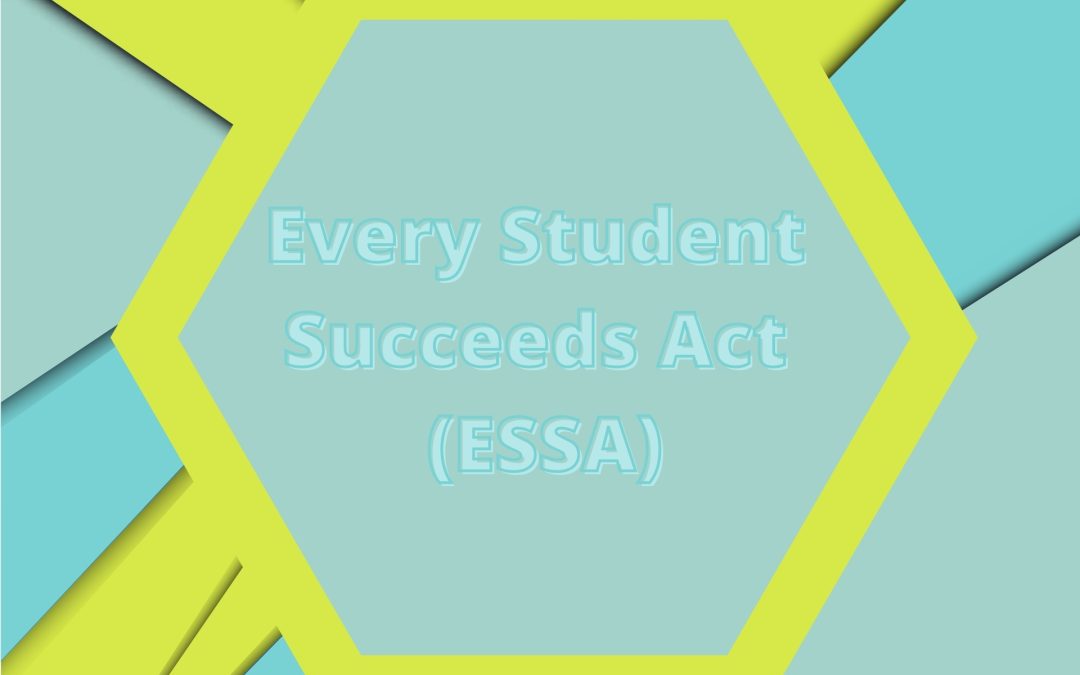ESSA OVERVIEW
In December of 2015, U.S. federal education law changed rather dramatically. As part of a long-overdue system review overhaul, the “Every Student Succeeds Act” (ESSA) was signed into law with full bipartisan Congressional support.
In short form, ESSA is the federal law that allows the U.S. Government to support both national and local education goals with grants and other resources. ESSA is intended to replace the 2002 No Child Left Behind ruling and re-authorizes the Elementary and Secondary Education Act (ESEA). The new “system” changes the old approach of broad federal oversight of K-12 education to a program that is intended to provide unprecedented state-and-local-level flexibility and “increased control over decision making” related to PreK-12 education vision and planning. The U.S. Department of Education published final ESSA regulations on November 28, 2016, and by doing so, pushed states to reconsider education planning for the 2016-17 and 2017-18 school years.
WHAT DOES ESSA REQUIRE?
Overall, ESSA identifies a way for schools to be accountable for student achievement. ESSA requires that states must
develop improvement plans to include challenging academic standards that specify the knowledge and skills that the State expects all its students to achieve, and to administer annual tests aligned with those standards. The state plans identify a process to be used to identify schools that are underperforming academically. Under ESSA, each state must include a certain specified set of requirements in its improvement plan.
(https://www2.ed.gov/policy/elsec/leg/essa/essa-flex.pdf)
“The bottom line is that each state has the freedom to choose the standards that describe the knowledge and skills every child is taught, and administered tests are designed to assess whether a student has achieved the standards.” https://www2.ed.gov/policy/elsec/leg/essa/index.html
PARENTAL INVOLVEMENT IN ESSA PLANNING
For parents, wading through the new Every Student Succeeds Act (ESSA) is not quick or easy, even in the form of parental guidelines and frequently asked questions. The law is incredibly complex, is over 1,000 pages long, and covers everything from accountability, to funding, to school building improvement. The regulations are written for educators, and even some seasoned educators have difficulty deciphering details of the law. The general purpose of the law is to fill gaps in educational opportunity and achievement while providing the opportunity to families, parents and communities to participate in decision making related to their own schools. (https://www2.ed.gov/policy/elsec/leg/essa/essatransitionfaqs11817.pdf), (https://www.esc16.net/upload/page/0463/docs/Stafford%201%20Over%20view%20of%20Parental%20Involvement%20Under%20ESEA%2005262016.pdf).
ESSA requires schools and school districts to involve parents in developing required improvement plans. This means that individual parents do have the opportunity to help their school determine what kinds of changes are needed to best meet the needs of the students in their child’s school. Based on this parent-supported planning effort, each state submitted a “consolidated” state plan under the Elementary and Secondary Education act of 1965 (ESEA) as amended by the new Every Student Succeeds Act (ESSA). The Department of Education then reviewed each state plan and determined whether-or-not individual plans were acceptable and could be implemented state-wide.
CAN A STATE OR SCHOOL DISTRICT REFUSE TO CONFORM TO ESSA?
ESSA is basically designed for public schools that receive federal funding, including Title I funds. Title I Funds are directed towards supporting the overall costs of education programming for low-income students. A Title I school is one where at least 40% of the student base comes from low-income families. If a public school does not use or require Title I or other specific federal funding assistance, ESSA may not apply to that school’s planning and development process.
Or, as a 2005 Department of Education publication related to ESSA’s predecessor, the No Child Left Behind Act, stated: ” “Any state that does not want to abide by a federal program’s requirements can simply choose not to accept the federal funds associated with that program. While most states choose to accept and use federal program funds, in the past, a few states have forgone funds for various reasons.” (http://blogs.edweek.org/edweek/campaign-k-12/2019/05/essa-questions-funding-title-I.html)
HOME SCHOOLS AND ESSA REGULATIONS
States actually do NOT have to follow ESSA requirements unless they wish to receive certain federal funding. Because home schools do not receive federal funds, home schools are not accountable to the terms of ESSA regulations.
CONCLUSION
ESSA states and school districts will still have to test all students, have curricular standards, and monitor progress by subgroups. ESSA will force [participating] states to pay more attention to English learners’ progress toward language proficiency and it will expand flexibility when it comes to measuring school quality. But the next steps for the nation’s education system don’t amount to a massive change in direction. (https://www.educationdive.com/news/federal-action-on-essa-may-not-change-much-for-schools/438185/). In the end, if a state doesn’t care about losing key federal funding, ESSA doesn’t really have the teeth to force a state to follow through on its plan, and a school district couldn’t be closed down because of ESSA.
